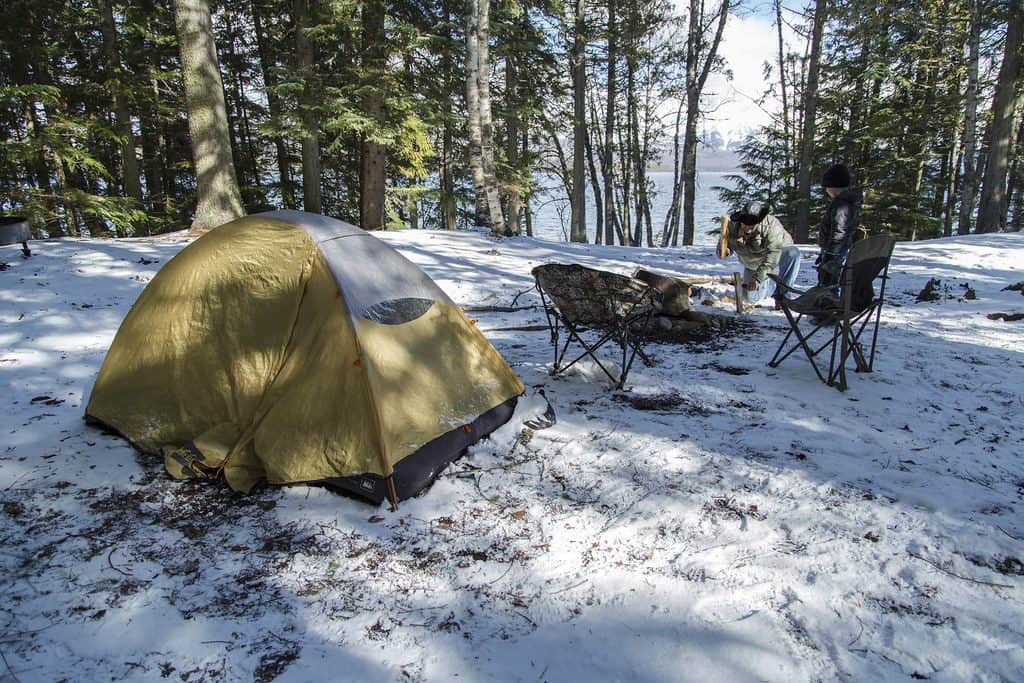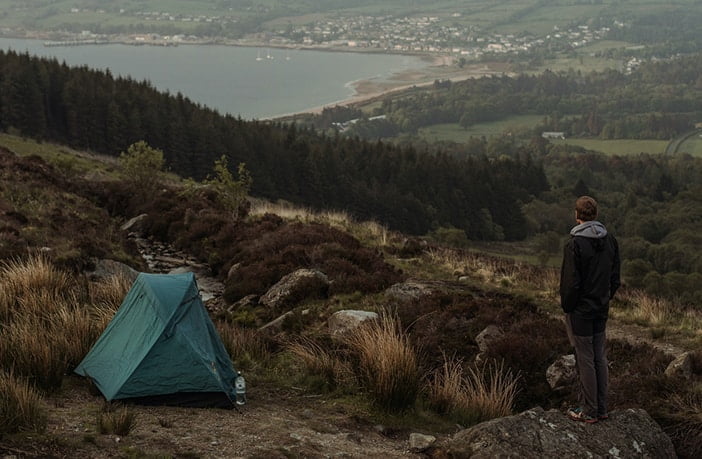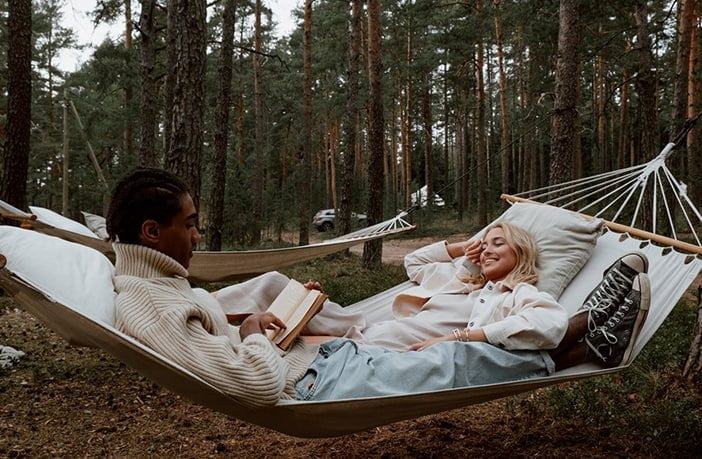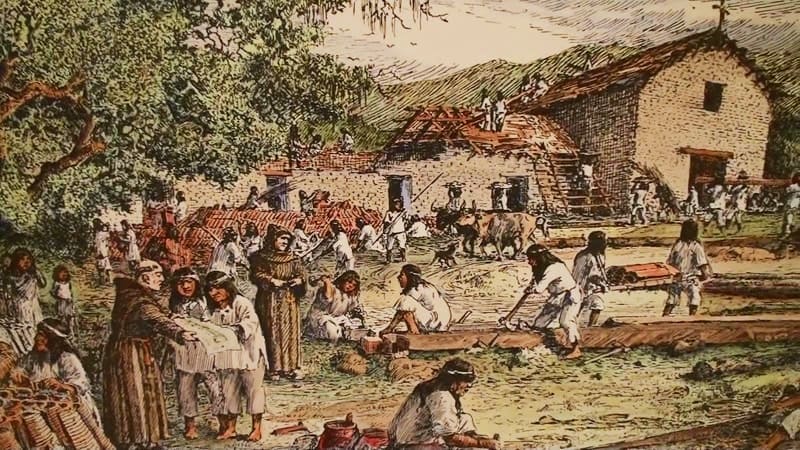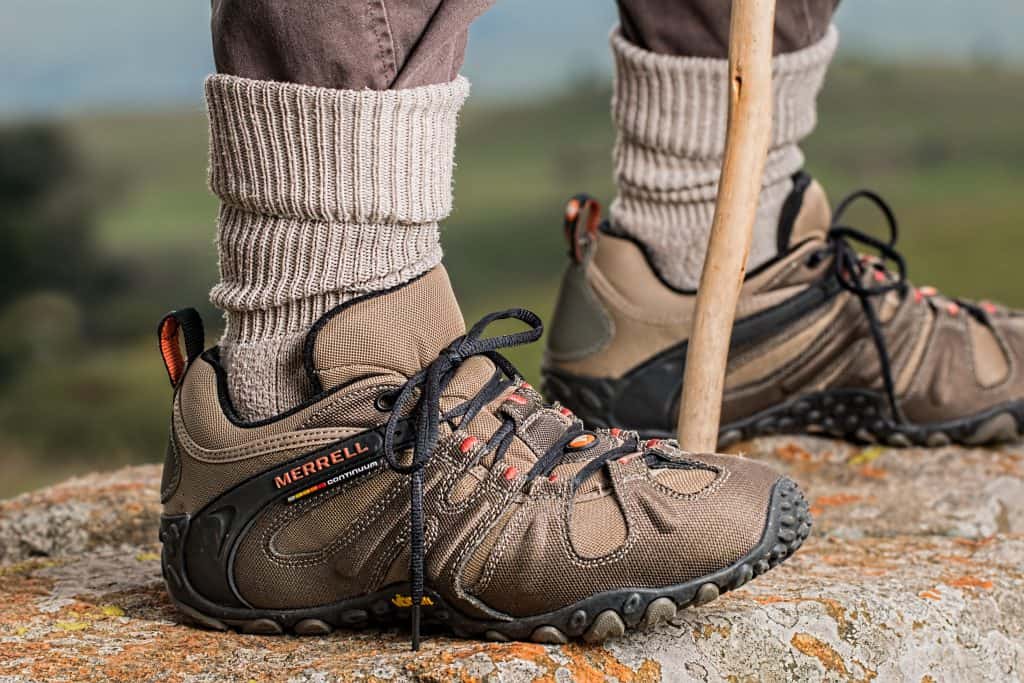Campfires usually smoke a lot either because you are using the wrong materials, or you have set up your campfire in an ineffective way. Making a mistake such as using wet wood or not having good airflow is likely the reason for your campfire smoking so much. Let’s learn more about how to prevent campfire smoke.
What causes campfires to smoke?
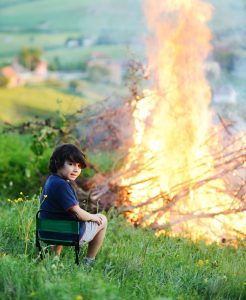
Now that you’ve learned how to build a proper campfire, you’ve already not only reduced a good chunk of smoke coming from your campfire but also managed to keep any remaining smoke right up against that back rock in one spot.
You’re now ready to go a bit deeper and investigate the why part a lot more thoroughly. The more efficiently your fire is burning, the less smoke it will produce.
In order for your fire to burn efficiently – it needs exactly 2 things:
- Fuel (quality wood)
- Oxygen (airflow)
The reason your campfire is smoking so much is probably because of the types of things you are throwing inside of it.
Think about it, if you got a brand new car, would you want to be filling it with bad fuel? Of course not!
1. Using improper wood
Just like using bad gas for your car, using wet or green wood to fuel your fire can also be quite problematic due to the moisture and wetness that both of those woods contain.
By the way, by “green wood”, I mean wood that is recently chopped down, not green in color.
You may be asking, what does wetness have to do with anything?
Well, if the wood you are using to make your fire is wet, it actually has a much harder time burning, and as a result, your fire will produce much more smoke since it is requiring more energy to burn the wood.
You will need to make sure any wood you have is dry. If you want tips on how to dry wood, you can visit my other post.
From all my experience camping, I’ve come to the conclusion that the perfect wood to use when making a campfire would be dry firewood, specifically kiln-dried wood.
Not only does it reduce the smoke coming from your campfire due to how well it burns, but it also burns rather slowly, causing it to last you a much longer time than most other types of wood.
There are also many other types of woods that can do the job, but my personal favorite is kiln-dried wood.
I guarantee you that once you switch to it, you won’t be making switching back from it any time soon.
2. Throwing things in your fire
You might be smoking your campfire excessively by throwing leaves, grass clippings, pine straws, or any other debris into it.
Similar to wet wood, adding debris like those mentioned above to your campfire can also lead to increased smoke production.
When a fire smokes, it indicates incomplete fuel combustion, hence using quality tinder can help improve combustion.
As a result, your campfire will burn effectively and cough up much less smoke.
3. Fueling it too quickly
If you throw in lots of wood into your campfire, it will be difficult to burn it and will produce more smoke.
Make sure to gradually build your campfire up, starting with the small sticks and twigs, and slowly adding on larger pieces of wood.
I usually make my life easier by buying fatwood fire starters. You won’t need to look for sticks, twigs, and other things.
This will help it burn cleaner, and as I said, the cleaner a fire burns, the less smoke that it will give off.
As you’re about to realize, aside from blocking the view or being annoying, campfire smoke can be dangerous for many other reasons, so please take my advice and lessen your exposure to that nasty smoke.
How to set up a proper campfire to prevent smoke?
First, if you’re using matches or some Bic lighter, I suggest you upgrade. I use the Everstryke by SurvivalLife, which you can buy here. It can both light a fire when soaked in water and lasts for decades.
EDIT: They’re now giving them out for free because of current world events!
Now let’s look at how you can actually build a proper campfire and at least reduce some of the smoke that comes from the fire pit.
If you’re reading this, you probably already know the traditional way of building a campfire, however, as you will see, that is an extremely inefficient way to do it as it actually causes more smoke to be produced.
In order to make the perfect fire, you ideally need two things – fuel and oxygen. The fuel being the wood and oxygen being the air.
The problem with setting up a fire pit the traditional way, with rocks all around the fire is that you are reducing some of the oxygen that the fire needs.
As a result, your fire will lack one of the two essential components, and give you a lot more smoke.
Do not worry, as these new methods to set up a campfire that I am about to show you will ensure that your fire gets all of the essential components – fuel and oxygen.
As long as your fire has both, the amount of smoke coming from your fire pit will be significantly reduced.
1. Building the perfect campfire
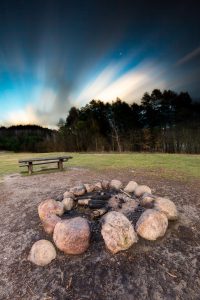
Let’s get started. First, you want to dig a hole in the ground, just barely below the surface, perhaps a few inches deep.
This will be your fire pit, or where you will be putting your wood.
Next, you want to surround that hole with rocks, just as you would normally, however, there is actually a twist in this new method.
You have to find out the direction from which the wind is blowing, and leave a gap in your rock circle, by removing a few rocks. In doing so, you are allowing oxygen to reach your fire much easier.
Opposite that gap, you want to place a large and tall rock, I’d say nearly around three times the height of all your other rocks.
What you have done here, is not only leave some space for oxygen to better fuel your fire but also, since the wind is blowing from one direction, all the smoke will just hit the back rock.
Smoke is attracted to objects, and with the back rock there, it will not only absorb some of the smoke but also push it so that it can only go in one place.
That means no more smoke following you around wherever you go, it will just be going up that back rock, just in one spot.
2. Creating a Dakota fire
If you do not want to follow the method above, I’ve found another great way of creating an efficient campfire.
This is one of the best methods I’ve found, although it could be a little difficult to make.
In short, you dig two pits that are linked by a small tunnel between the pits. You put the wood in one pit, while the other pit provides the oxygen needed for the fire to keep burning.
The way that this prevents campfire smoke is that it provides just enough airflow for the wood to burn.
It limits the oxygen supply which in turn makes less smoke. The small supply of oxygen also means your wood will burn slower, which in turn gives you a longer campfire.
This is one of the most effective campfires for conserving wood and preventing campfire smoke.
For additional tips on how you can DIY a smokeless fire pit, check out this article. It may not be completely smoke-free although you will notice that the benefits are pretty visible.
3. Use a Portable Firepit
Recently I went down to Arizona to meet up with an old buddy of mine so that we could go camping for the weekend.
Earlier in the day, he was telling me about however since he had bought some new grill, he’d fallen in love with it, and that what it could do would definitely surprise me.
There was absolutely no smoke coming from it, and we did not have to put in the effort we usually would make our campfire smokeless with the natural methods that I’ve explained above.
This excited me because you cannot get rid of all campfire smoke from a naturally made campfire.
There are many different portable firepits, but the best one I found was the BioLite FirePit.
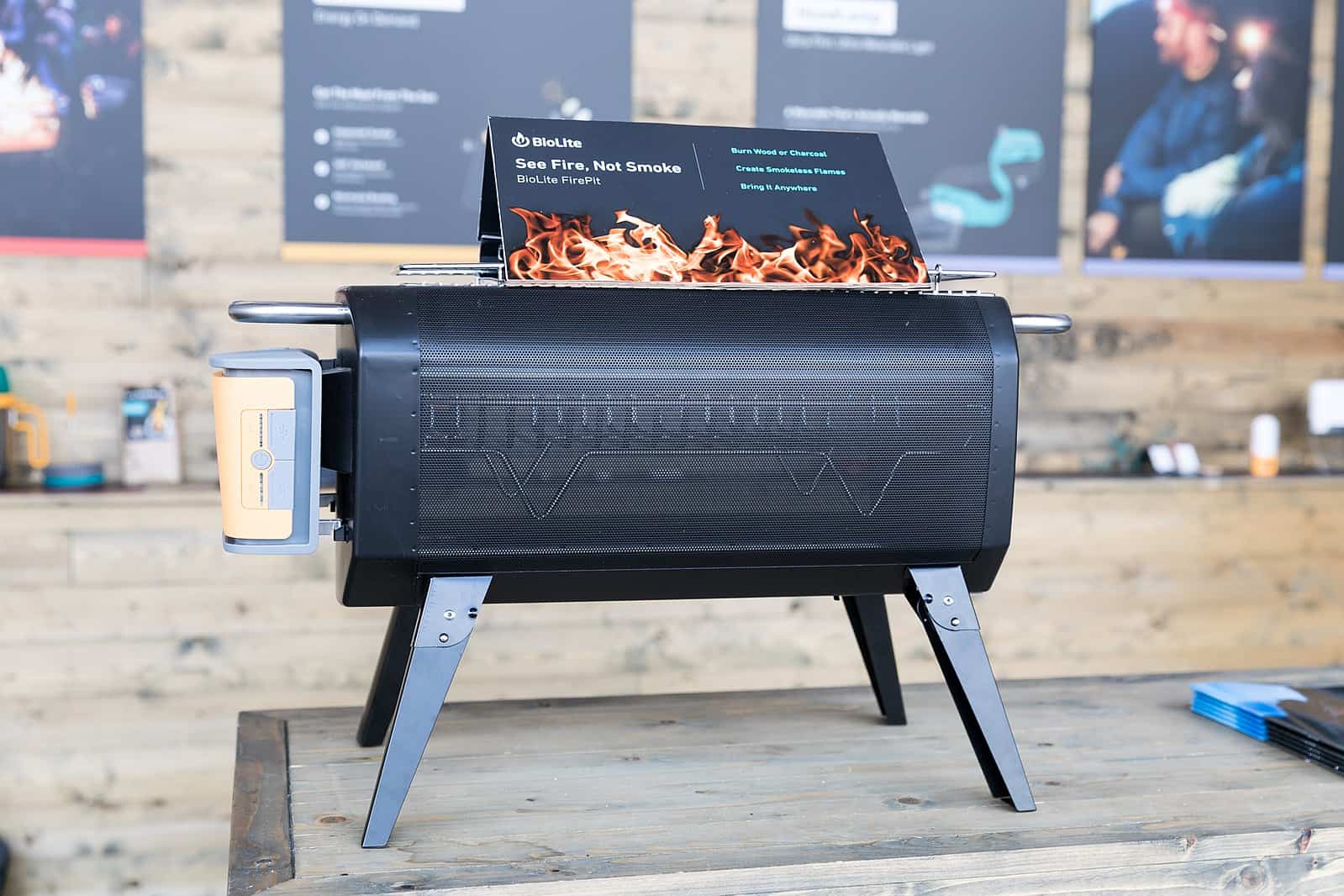

You get to look inside it as it cooks your meals and you can also use it like a campfire. It’s fully smokeless.
The firepit weighs around 20 lbs, and it’s only 10 inches high, so it is portable, especially with the side handles. It also has a carry cover, which is quite nice.
It uses firewood or charcoal as fuel, and the battery on it is enough that it could burn for days on end.
You can also control the fire with an app on your phone, as it uses Bluetooth to regulate the intensity of the flames of the firepit.
Cooking is much easier with this as you don’t need a separate grill, fire pit, and chimney firestarter when instead you can just use the firepit for all three of those functions in the course of one evening.
Oh, and I almost forgot, if you’re worried that it might make a mess and that it looks hard to clean, let me tell you, it’s the easiest thing to clean, and I really mean that.
Why you should prevent campfire smoke?
1. Campfire smoke can be bad for your health
It has very serious health effects and can leave a very bad smell behind.
Campfire smoke is composed of:
- Dangerous particles
- Carbon monoxide
- Sulfur dioxide
- Nitrogen oxides
Now you wouldn’t want any of that entering your system, would you?
If you have underlying health conditions such as asthma or bronchitis, the smoke coming from your campfire can worsen them.
2. Cooking experiences will be ruined
Sure, campfire smoke could leave a nice smoky flavor on some foods, but you wouldn’t want to overdo that. All campfires smoke to a certain extent, what’s important is making sure it doesn’t smoke too much.
Remember that too much smoke will destroy your food!
I can’t say I’m a fan of the smoky flavor when cooking anything other than meat.
It’ll ruin your cooking experience, and you might want to head back home to find some better food to eat.
It’s not worth letting your camping experience get ruined, so just be prepared and educated instead.
3. It can cause environmental damage
Pfft, what will some smoke do to the Earth?
Combining your campfire with everyone else’s smoky campfires can be quite harmful to the environment.
Hundreds of people lighting campfires in one area day by day will eventually create a haze in the nearby area.
The air having tons of dust and particles means that the animals along with the wonderful plants will be affected by this
Remember, we should save the planet, not do more damage to it!
Just learn the proper way to making a non-smoky, eco-friendly campfire and you’ll be good to go!
4. It will cause your clothes to smell like smoke
Smoky clothes! Yuck!
If you’ve ever had a campfire before, then you know that horrible smell that sadly gets stuck to your clothes.
Getting the smell of smoke out of clothes can be incredibly difficult.
To prevent your clothes from smelling like smoke, you must have a non-smoky campfircine.
In case you haven’t gotten your clothes to smell like smoke yet, trust me, you shouldn’t want to try them.
I’ve tried over seven different methods to remove smoke from this one shirt of mine, and oh boy, even after 5 years I can still somewhat smell the smoke (isn’t that crazy?!).
5. It can be dangerous for kids or the elderly
If you happen to have children, elderly people, or pregnant women around you, it’s probably a good idea to limit the smoke exposure.
There are many effects of campfire smoke that can be especially detrimental to kids, elderly people, and pregnant women.
Kids are the most susceptible to smoke as they are still developing.
I like to think of campfire smoke like cigarette smoke.
You should still try to do your best to limit your exposure to it, and especially so if you happen to have children, elderly people, or pregnant women inhaling the s
6. It will ruin the view
Turns out the haze produced by campfire smoke isn’t only bad for the environment, but for us as well.
With all the haze and campfire smoke in the way, you won’t be able to enjoy some traditional camping experiences like stargazing or simply just laying back and enjoying the view.
Instead, it’ll be foggy and hazy and you won’t be able to see anything.
You wouldn’t want that, would you? Well of course not, no one would!
With a bit of extra work in making your campfire not smoke so much, I promise you that your camping experience will be much more pleasant.
7. It can attract unwanted visitors
If you want to be a bit more isolated from everyone else while camping, having a smoky campfire won’t exactly help you with that.
In fact, when my wife and I were younger, we’d always have a perfect hidden camping spot.
No one else would come to it, however, one day when we had our campfire up, another family came over to talk to us. We didn’t think much of it, but weeks later, guess who we saw?
Yup, the family. They had taken our camping spot, and ever since then, we had to change up areas just because of our smoke.
Not only people, but animals as well can be lured in by the smoke, so if you’re planning on having a smoky campfire, make sure to be prepared for all sorts of guests.
Quick Summary
Though I already covered part of this above, here’s a quick overview of what works to reduce campfire smoke.
- Set up your campfire properly. It is crucial you organize the way you put wood in your fire and structure it similarly to a tepee in order to promote more airflow.
- Gradually add more wood. Throwing in a bunch of wood blocks airflow and causes your campfire to smoke a lot. Just gradually build onto it, ensuring that your fire cleanly burns all the wood.
- Do not use wet or greenwood. Using wet or green wood makes it more difficult for your fire to burn it, so as a result, it will produce a lot more smoke due to the more energy required for it to burn.
- Use kiln-dried firewood. Not only will it cause your campfire to smoke much less, but it will last much longer than any other type of wood. Like I already said, the better a fire burns, the less smoke produced, and kiln-dried firewood burns extremely well.
- Avoid woods like Poplar, Elder, or Robinia. Even when dry, they will still produce a lot of smoke as they are naturally smoky woods. They do not burn as well, and are just not high-quality tinder for your fire, trust us on this one.
- Don’t throw debris into your campfire. I would not recommend tossing leaves, any types of green things (plants or grass), pine straw, or really any other debris into your campfire if you want to reduce the smoke coming from it.
- Maintain your campfire with hardwoods. Sure, you can use softwoods to start it, but I strongly recommend using hardwoods to maintain your fire as they burn much more efficiently and produce way less smoke.
- Remove all green near your campfire. They will just add unnecessary wetness to your fire and as a result cause it to produce a lot more smoke.
- Use a BioLite FirePit. This is the only way to truly have a smokeless campfire. It works like a charm every single time, and I’ve never been disappointed by it yet.
I wish you good fun on your next journey!
Sean is an accomplished backpacker with over 10 years of experience exploring the great outdoors. He has a passion for hiking, camping and off-grid living.

